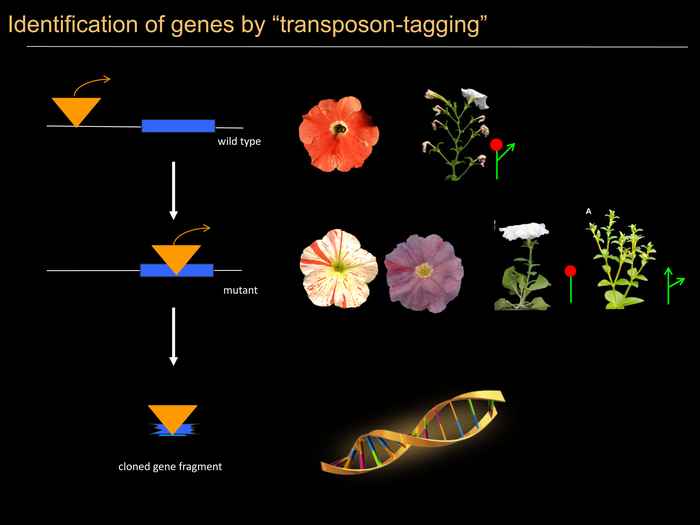Plant Development & Genetics
Group leader Prof. Ronald Koes
Plant and animals display a remarkable diversity of their morphology. We aim to better understand the molecular details of how such diversity arose during evolution. To this end we study regulatory networks that govern the development of flowers in different species, with particular emphasis on the differentiation of petal cells that cause the wide spectrum of flowers colors in different species. Flower color is a particularly attractive model system as mutations that affects this process are easy to identify.
The final color of a flower is a remarkably complex trait determined by a combination of processes. This includes (among others) the synthesis of pigments, but also colorless co-pigments, their stable accumulation in vacuoles, regulation of vacuolar pH, the determination of cell shape (and thus their optical features) and the genesis of additional organelles. Mutations affecting any of these basal cellular processes are immediately evident by a change in flower color.
Most of the red and violet colors of flowers and fruits are due to the accumulation of anthocyanin pigments, while yellow and orange colors are in most cases due to the accumulation of carotenoids. Anthocyanins consist of a backbone (two aromatic rings connected by a heterocyclic ring) that can be “decorated” with hydroxyl and methyl groups, a variety of sugars and acyl groups resulting in a wide variety of colors ranging from orange to violet.
Through the analysis of petunia flower color mutants we discovered a transcription factor complex, called MBW or MBWW, that governs the tissue-specific transcription of the structural anthocyanin genes (which encode the enzymes of the pathway) and thereby the pattern of pigmentation. It proved that MBWW governs at least two additional pathways, involved in (i) hyper-acidification of the central vacuole and (ii) trafficking of proteins and vesicles to the central vacuole, via ‘vacuolinos’, which are small vacuoles that co-exist with the large central vacuoles.
Also carotenoid pigments exist in a large variety of structures which correspond to different colors. The regulation of their synthesis is much less well understood then that of anthocyanins. These two classes of pigments have also very different properties and accumulate in plastids while anthocyanin are stored in vacuoles.

Plants like petunia and arabidopsis are suitable models for these studies presenting large differences and being easy to isolate mutants and to produce transgenics. We analyse sets of genes involved in both pigmentation pattern and inflorescence architecture to unravel whether different expression is the consequence of differences in their promoters or in the protein regulating their transcription. This gives insights in how genes determine the body plan of an organism and which changes in the same genes led to the different patterning during evolution. Petunia offers the possibility to easily isolate mutants for any gene thanks to a very active set of transposons which, by jumping around and landing in new places in the genome, continuously generate new mutants. New mutants in unknown genes are found by simply growing population of a specific line with high transposition activity. Once a mutant is identified, the isolation of the gene is simple as the transposon sequence is known.
Flower pigmentation, flower and inflorescence architecture have been for many years the category for which we have isolated the most mutants, as these are the main subject of studies for us, however, also other type of mutants are present in the collection.
The colour displayed by flowers gives a great opportunity to approach all kinds of phenomena related to gene expression regulation, as any change result in an easy to score change in flower colour. Using these tools, our group has cloned and characterised several genes of the pathway for the production and accumulation of anthocyanins (the main plant pigments), transcription factors regulating expression of such a pathway, genes involved in the regulation of environment in cellular compartments and discovered gene silencing (van der Krol, A.R., et al. (1988). Nature 333, 866-869).
Via the spontaneous generation of mutants in petunia, several previously unknown process got described and became articles in high impact journals (not only by our group).
